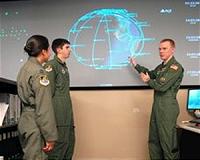| . |  |
. |
Ft Lauderdale FL (SPX) Feb 25, 2010 Soldiers participating in the U.S. Army's recent Expeditionary Warrior Experiment (AEWE), Ft. Benning, Ga., were able to acquire unprecedented levels of knowledge about their surroundings thanks to the battlefield imaging and communications relay capabilities of Northrop Grumman's Fire Scout vertical unmanned aerial system (VUAS). Hovering 4,000 feet above the battlefield, Fire Scout offered soldiers both high fidelity video imagery produced by its electro-optical/infrared (EO/IR) sensor, and assured, Internet-like chat, file sharing and data transfers enabled by a Raytheon-produced communications payload. "Fire Scout's delivery of assured communications to AEWE participants demonstrated yet another benefit of using vertical unmanned aerial systems to support warfighters, particularly those operating in remote, rugged territory," said Al Nikolaus, Northrop Grumman's Land-based Fire Scout program manager. AEWE is an annual Army exercise designed to give soldiers a look at emerging battlefield technologies and concepts of operation. In addition to Fire Scout's communications relay demonstration, the VUAS was used to support cargo resupply missions and to ferry other types of unmanned systems to troops operating in remote areas. For the communications relay missions, Fire Scout was equipped with a Mobile Ad hoc Interoperability Network GATEway (MAINGATE) communications payload. Installed in a pod attached to Fire Scout, the payload relayed communications among ground troops, allowing them to share high quality video, voice and data communications in real time. Northrop Grumman also fed Fire Scout's EO/IR surveillance imagery into the MAINGATE network in real time, allowing soldiers to benefit from the VUAS' "perch and stare" view of the AEWE battlefield. According to Nikolaus, one of the most significant aspects of the communications relay demo was how fast the payload was integrated on Fire Scout and flown successfully on multiple AEWE missions: from start to finish, the process took less than three months; installation, check-out and first flight of the MAINGATE hardware at AEWE took just one day. "The success of the MAINGATE demo reinforces the maturity and versatility of Fire Scout's modular design," said Nikolaus. "Backed up by Northrop Grumman's expertise in unmanned systems, the system can deliver a lot of capability to the warfighter in very short order." Fire Scout is an autonomous, unmanned helicopter based on a Sikorsky Aircraft commercial airframe. Equipped with a variety of EO/IR and communications payloads, it can provide high levels of situational awareness and precision targeting support to U.S. armed forces for more than five hours at a time. Fire Scout can take off and land autonomously on any aviation-capable warship, and at prepared and unprepared landing zones in proximity to ground troops. Its ability to operate at low ground speeds allows it to move with warfighters in the field, and easily acquire and track targets in complex and urban terrain. It can also perform 'dull, dirty, or dangerous' missions, thereby protecting soldiers from harm's way. Northrop Grumman is developing Fire Scout vertical unmanned systems for a variety of U.S. and international military customers.
Share This Article With Planet Earth
Related Links Northrop Grumman Read the latest in Military Space Communications Technology at SpaceWar.com
 JFCC-Space Continues To Support Haiti Mission
JFCC-Space Continues To Support Haiti MissionVandenberg AFB CA (AFNS) Feb 19, 2010 Vandenberg AFB CA (AFNS) Feb 19, 2010 Members of the Joint Functional Component Command for Space here are continuing to support relief efforts in Haiti by providing space effects such as satellite communications and position timing and navigation services. At any given time, up to 200 personnel, including the JFCC-Space staff, Joint Space Operations Center and JFCC-Space tactical units, ... read more |
|
| The content herein, unless otherwise known to be public domain, are Copyright 1995-2010 - SpaceDaily. AFP and UPI Wire Stories are copyright Agence France-Presse and United Press International. ESA Portal Reports are copyright European Space Agency. All NASA sourced material is public domain. Additional copyrights may apply in whole or part to other bona fide parties. Advertising does not imply endorsement,agreement or approval of any opinions, statements or information provided by SpaceDaily on any Web page published or hosted by SpaceDaily. Privacy Statement |